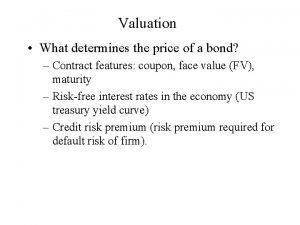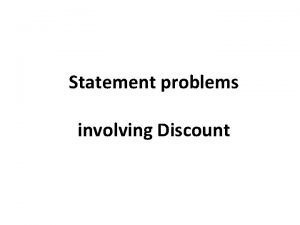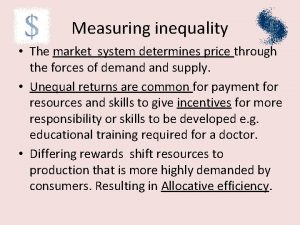WHAT DETERMINES PRICE NATURE OF THE MARKET Prices








- Slides: 8

WHAT DETERMINES PRICE?

NATURE OF THE MARKET • Prices is influenced by: – The Nature of the Market – Consumer Demand of Product – Production and Marketing Costs – Consideration of Channel Members • Before pricing is established, you must recognize what type of market you are in: – Pure competition, – Monopolistic competition – Oligopoly – Monopoly

PURE COMPETITION • In pure competition, there are many small firms marketing the same basic product; therefore, no single firm can dictate or offset the market • Commodities such as wheat, barley, and sugar fall into this category because they have no choice but to charge the going rate of the products

PURE COMPETITION • In the case of pure competition, it is the market that controls the price • Often, the prices determined by the market rely simply on supply and demand • Sometimes, the price can be determined by expectations about supply and demand for a certain product • For example, if it was predicted that the supply of gas was to go down there would be a rush to buy gas forcing the demand to go up and the supply to go down • This expectation would therefore cause a rise in the price of gas in the market

MONOPOLISTIC COMPETITION • In monopolistic competition, there are many competitors selling the same product that, though similar, are perceived to be different by customers • Companies selling good such as coffee, cereal, or tooth paste market their brand as “different” or “superior” in order to distinguish it from others • Factors such as quality, service, style, function, and packaging are used to convey a difference to the consumer • These qualities are known as “non-price competition” and create the presence that brands such as Colgate are superior products and can be sold for more

MONOPOLISTIC COMPETITION • Traditionally consumers have been willing to pay more for a few items due to brand loyalty • With the decrease in disposable income however this trend is shrinking • Lower priced products therefore are becoming increasingly more successful in selling products rather than factors such as quality

OLIGOPOLISTIC MARKET • In a oligopolistic market, there a few large sellers of a particular good or service • Examples od such industry's are the brewery industry (dominated in Canada by Molson and Labatt) and the gasoline industry dominated by (Petro-Can, Imperial Oil, and Shell) • In oligopolistic markets, competitors watch each others actions and prices extremely closely • For example, if a gas station raises or lowers its price, competitors will do so shortly after

MONOPOLY • A monopoly is when a single seller with no similar substitutes serves the market • With this amount of power, companies can manipulate supply and demand therefore change pricing in the market • In Canada monopolies are rare but do exist, examples include Sask. Power and Hydro-Quebec















